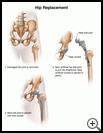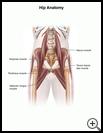
Hip Replacement Surgery
What is hip replacement surgery?
The hip is a joint where the top of the bone in your upper leg (called the femur or thighbone) meets the pelvic bone. The hip joint is called a ball and socket joint. The top of the femur (called the femoral head) is rounded, like a ball. It fits into a concave area (socket) on the pelvic bone, called the acetabulum.
Hip replacement surgery is a procedure done to remove a painful, broken, or diseased hip joint and replace it with an artificial hip joint. If both the femoral head and socket need to be replaced, the surgery is also called total hip arthroplasty or THA. If only the femoral head needs to be replaced, the surgery is called a partial hip replacement, or hemiarthroplasty.
You may need hip replacement surgery if you have:
- Severe pain from arthritis in the hip that limits your ability to do the things you want to do
- A broken hip
- A tumor in the hip joint
How is hip replacement surgery done?
Before the procedure:
- Your healthcare provider will ask you to sign a consent form for hip replacement surgery. The consent form will state the reason you are having the procedure, what happens during the procedure, and what you may expect afterward.
- There is risk with every treatment or procedure. Talk to your healthcare provider for complete information about whether any of these risks apply to you:
- Anesthesia problems
- Infection
- Blood clots
- Bleeding
- Tell your healthcare provider if you have any food, medicine, or other allergies such as latex.
- Tell your healthcare provider if you are taking any medicines, including nonprescription drugs, herbal remedies, or recreational or illegal drugs.
- You will have a small tube (IV catheter) inserted into a vein in your hand or arm. This will allow for medicine to be given directly into your blood and to give you fluids, if needed.
During the procedure:
- A cardiac (heart) monitor will be used to keep track of your heart rate and rhythm.
- Your blood oxygen level will be monitored by a sensor that is attached to your finger or earlobe.
- You will be given a sedative through your IV to help you to relax.
- You will be given medicines to prevent pain during your surgery. These may include:
- Regional anesthesia, which numbs a large area of your body.
- General anesthesia, which relaxes your muscles and puts you into a deep sleep. It also keeps you from remembering the operation. While you are asleep, you will have a tube in your throat to help you breath and to make sure you are getting enough oxygen. The tube may be removed before you wake up after the surgery.
- You may have a small tube (catheter) placed into your bladder to drain and measure urine.
- The surgeon will replace the hip by:
- Making a cut in the skin and tissues over your hip joint and upper leg to see the bones
- Cutting and removing the top of the femur that is damaged or diseased
- Placing an artificial (metal or ceramic) femur head in place of the bone that was removed
- If necessary, smoothing out the diseased or damaged part of the pelvic bone and placing an artificial (plastic, metal, or ceramic) socket in the hollow area to hold the new femur head
- The skin and tissues will be closed with stitches or staples.
- Temporary drains may be left in the cut so blood and fluid can drain.
After the procedure:
- You will be checked often by nursing staff.
- Your heart rate, blood pressure, and temperature will be checked regularly.
- There will be a bandage on your hip. It will be checked and changed by your provider or the nursing staff as needed.
- Your legs will be kept in the correct position to prevent hurting your hip.
- Your leg may be moved regularly with a machine to help muscle and bones heal. This is called continuous passive motion or CPM.
- Your provider may prescribe medicine to:
- Treat pain
- Treat or prevent an infection
- Treat or prevent side effects, such as nausea or constipation, from other treatments
- Help prevent blood clots
- Help build bone and prevent bone loss
- Your provider may recommend other types of therapy to help relieve pain, other symptoms, or side effects of treatment.
- Temporary tubes may be left in place to drain blood and fluid. They will be checked and emptied regularly.
- You will need therapy to help you recover from a hip replacement surgery. Most rehabilitation programs include:
- Physical therapy to help you regain muscle strength and teach you ways to move safely
- Occupational therapy to help you relearn safe ways to move your hip and do the tasks that you did before your hip replacement surgery
What can I do to help?
- You will need to tell your healthcare team if you have new or worsening:
- Pain that is not controlled with your medicines
- Swelling in your leg, ankle, or foot on the side of your hip replacement
- Coldness or change in color of the skin of your leg, ankle, or foot on the side of your hip replacement
- Warmth, redness, or pain in your leg
- If you are taking medicine to prevent blood clots, unusual or unexpected bleeding
- Redness, swelling, pain, warmth, or drainage from your surgical wound
- Fever, chills, or muscle aches.
- Ask questions about any medicine, treatment, or information that you do not understand.
How long will I be in the hospital?
How long you stay in the hospital depends on many things, such as your general health, why you are in the hospital, and the treatment you need. The average amount of time to stay in the hospital with hip replacement surgery is 3 to 5 days. Talk with your provider about how long your stay may be.
You may need to go to a rehab facility to continue your hip replacement rehab program before going home.
Last modified: 2016-02-08
Last reviewed: 2015-12-21


